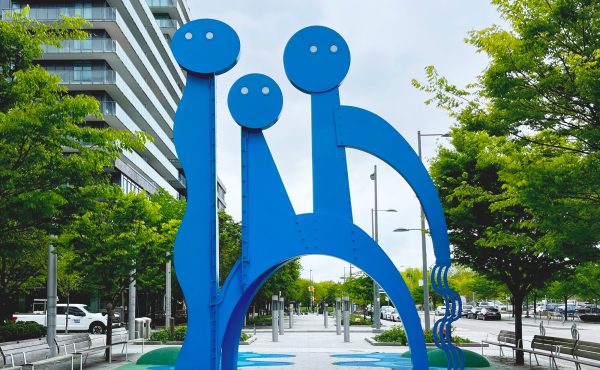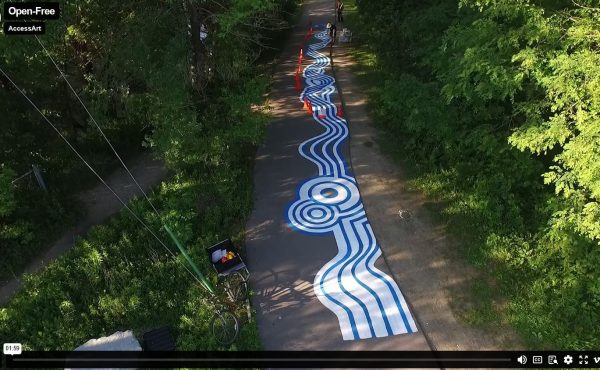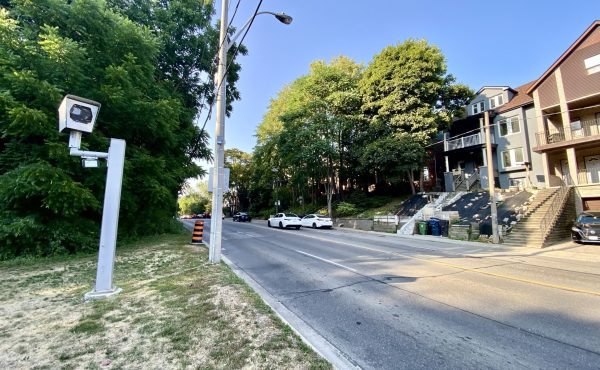
Though only in Dublin a very short time, I got the feeling it’s a happy city. And a public one. The streets in the city centre are absolutely full of people. Human traffic jams at times. It may have helped that it was an exceptionally warm and a spring-has-sprung effect was taking over, but Dublin just gave off the right kind of vibe.
Above is Grafton Street, one of two pedestrianized high streets, with some of the highest retail rents in Europe. They had guys out with those mini-Zamboni street cleaners scrubbing the red bricks like it was the Eaton Centre. Also, workers had motorized hand-carts that they used to empty trash bins. For streets like this, the machinery used to maintain it is built on a smaller scale. One of the reasons Toronto is having such difficulty in shrinking the size of our streets is difficulty in getting organizations like the fire department to use some smaller vehicles.

 Over on Henry Street, the other pedestrianized area, the retail is less posh, the paving stones less fancy, but it’s no less full of life. Like many European cities, it’s illegal to post ads — and there is a limit to billboards — so some enterprises hire these folks to sit or stand all day holding a sign, which just skirts the regulations. I remember these people all around London as well. The guy above was caught in mid-yawn. Unlike London, many brought chairs with them.
Over on Henry Street, the other pedestrianized area, the retail is less posh, the paving stones less fancy, but it’s no less full of life. Like many European cities, it’s illegal to post ads — and there is a limit to billboards — so some enterprises hire these folks to sit or stand all day holding a sign, which just skirts the regulations. I remember these people all around London as well. The guy above was caught in mid-yawn. Unlike London, many brought chairs with them.

 In 2004 Dublin opened the Luas (Irish for “speed”) light-rail system. I was told getting around Dublin is difficult, and traffic is a major problem. Dublin has grown tremendously in the last few years so the transportation system has been overwhelmed. There are only two lines so far, but more are planned. It runs these great articulated trams that glide through the city and are wheelchair accessible at all stops. Paint them red and they’d be perfect replacements for Toronto’s current streetcars. It works on an honour system much like the Queen Street POP system does, but you buy tickets from little automated machines at the stops, not from the driver.
In 2004 Dublin opened the Luas (Irish for “speed”) light-rail system. I was told getting around Dublin is difficult, and traffic is a major problem. Dublin has grown tremendously in the last few years so the transportation system has been overwhelmed. There are only two lines so far, but more are planned. It runs these great articulated trams that glide through the city and are wheelchair accessible at all stops. Paint them red and they’d be perfect replacements for Toronto’s current streetcars. It works on an honour system much like the Queen Street POP system does, but you buy tickets from little automated machines at the stops, not from the driver.
Though European cities have a reputation for being extremely walkable — and they are — I found it frustrating that the light cycles are excruciatingly slow, leading to lots of jaywalking (dangerous when you forget which way to look for traffic). I saw this countown timer, but I didn’t realize until I was in the middle of the intersection and a car was honking at me that they countdown to the green, rather than to the red. I suspect because cycles are long, they installed these to make people more patient while they wait. And wait.

Like in the UK, there are some fine and lovely examples of 1970s brutalism that everybody seems to hate as a matter of reflex. Architecture “built for a civil war” one of the people touring me around said. There is lots of it up in Belfast, where there was just that during the years this was popular to build. In twenty years, we’ll love this stuff as much as Victorian gingerbread I bet. Luckily it’s more difficult to tear this stuff down, so maybe it’ll still be around.



 Graffiti is not widespread in Dublin — at least in the city centre — but there are pockets. The guy above was in the middle of doing some large scale commissioned work on Docklands construction hoarding. The closest thing that I found to Toronto’s Queen Street Graffiti Alley is Windmill Lane, the studio where U2 recorded the albums that everybody owns. Even the people who profess not to like U2 own the Joshua Tree, it seems. Like EMI’s Abby Road studios in London, it’s been covered by fans. Don’t know about the damsel in distress though — found her under railway tracks nearby.
Graffiti is not widespread in Dublin — at least in the city centre — but there are pockets. The guy above was in the middle of doing some large scale commissioned work on Docklands construction hoarding. The closest thing that I found to Toronto’s Queen Street Graffiti Alley is Windmill Lane, the studio where U2 recorded the albums that everybody owns. Even the people who profess not to like U2 own the Joshua Tree, it seems. Like EMI’s Abby Road studios in London, it’s been covered by fans. Don’t know about the damsel in distress though — found her under railway tracks nearby.

 Along the River Liffey northern quay are these thin figures by Irish sculptor Rowan Gillespie. They mark the long walk people took when fleeing the Irish Potato famine. In the upcoming spring issue of Spacing, we’ll have an article about Ireland Park opening at the foot of Bathurst in June, where four more of Gillespie’s sculptures will be marking their arrival. The metal is very rough to touch. Having them in the spot where this long walk actually happened, and letting people walk around them rather than having them cordoned off, made it more of a performance than a static sculpture. Due to Ireland’s massive economic growth in recent years — the Celtic Tiger phenomenon — people are moving to the island, after decades and centuries of people leaving.
Along the River Liffey northern quay are these thin figures by Irish sculptor Rowan Gillespie. They mark the long walk people took when fleeing the Irish Potato famine. In the upcoming spring issue of Spacing, we’ll have an article about Ireland Park opening at the foot of Bathurst in June, where four more of Gillespie’s sculptures will be marking their arrival. The metal is very rough to touch. Having them in the spot where this long walk actually happened, and letting people walk around them rather than having them cordoned off, made it more of a performance than a static sculpture. Due to Ireland’s massive economic growth in recent years — the Celtic Tiger phenomenon — people are moving to the island, after decades and centuries of people leaving.

Dublin has some of the fiercest, medieval-looking barbed wire schemes I have ever seen.

There are very few greenspaces in the city centre. This playground was just about completely paved over. I was also told there are very few places in Dublin where large crowds can gather, making it difficult to hold public festivals without closing streets — something itself hard to do because of traffic conditions.


 However, St. Stephen’s Green, at the end of Grafton Street, is an oasis of green. It’s a formal garden with low wrought iron rails keeping people from walking on the grass. The feeling of that sudden transition from dense city to all this luscious greenspace (perhaps seeming even more green for a Torontonian) is what Frederick Law Olmstead meant when he said parks “are the lungs of a city.” With a little care and maintenance, Toronto’s Allen Gardens could be as wonderful (the conservatory there already is).
However, St. Stephen’s Green, at the end of Grafton Street, is an oasis of green. It’s a formal garden with low wrought iron rails keeping people from walking on the grass. The feeling of that sudden transition from dense city to all this luscious greenspace (perhaps seeming even more green for a Torontonian) is what Frederick Law Olmstead meant when he said parks “are the lungs of a city.” With a little care and maintenance, Toronto’s Allen Gardens could be as wonderful (the conservatory there already is).



The Dublin Docklands area looks like Dubai with a forest of construction cranes. My hotel overlooked a new park just about to open full of huge red poles that glowed at night. The lower picture (above) is remarkable only because this is the hole where the “U2 Tower” will go — controversial as it will be the tallest building in Ireland.

 Dublin lives in people’s imaginations more than a place like Toronto does, because it’s older, and because it plays such a central role in English literature’s cannon. I was told to look out for the the feet and arrows above, as they are there to evoke Leopold Bloom wandering around the city in Ulysses. There are also lots of these little plaques (at right) that include the bit of text where that specific location is mentioned. Last year we recorded authors of books nominated for the Toronto Book Awards reading from their work where it involves a geographic location, and installed [murmur] ears there. Dublin’s lucky that Ulysses is often considered the greatest modern novel. Maybe all it takes is some PR, and Toronto just needs to get people to start reading the stuff already written.
Dublin lives in people’s imaginations more than a place like Toronto does, because it’s older, and because it plays such a central role in English literature’s cannon. I was told to look out for the the feet and arrows above, as they are there to evoke Leopold Bloom wandering around the city in Ulysses. There are also lots of these little plaques (at right) that include the bit of text where that specific location is mentioned. Last year we recorded authors of books nominated for the Toronto Book Awards reading from their work where it involves a geographic location, and installed [murmur] ears there. Dublin’s lucky that Ulysses is often considered the greatest modern novel. Maybe all it takes is some PR, and Toronto just needs to get people to start reading the stuff already written.




9 comments
Hi Shawn;
Great post. If you haven’t seen it already, there’s an interesting cartographic project based on walking James Joyce’s (Ulysses) Dublin, here. It’s mapping/technology/media researcher Carol Strohecker’s Amble Time project. Very neat stuff.
Amy Lavender Harris
My wife and I had a great time in Dublin last year and really fell in love with the city. Thanks for taking me down memory lane.
One thing we loved in Dublin was being able to hop on a train for about half an hour to take us to a ‘suburb’ of Dublin that’s actually a small coastal town. I think it’s called Greystones. It was great to be able to get into such a beautiful bit of a nature with such a short train trip.
Plus, look what we found, to our surprise, in Dublin.
Moreso than the Luas, the thing that always impresses me in Dublin is the DART. It’s what Toronto really needs and what GO Transit should strive to be… reliable, frequent all-day commuter rail connected to a well-thought-out feeder bus system.
Hope you made it out to Phoenix Park or the Hill of Howth (it’s such a great place for walking and has such a wonderful view), or to the Bad Ass Cafe (right the other side of the brutalist bank in Temple Bar).
Tom> You can’t escape Tim Hortons I guess. I didn’t see any though.
John> Ya, the DART looked neat, and trains were always rumbling by. It didn’t go to the airport, so I didn’t ride it.
Didn’t make it outside the city-core much, due to time. I did go for evening run on saturday night to the Sandymount area just to the south of the docklands, and along the North Sea beach. The tide was out so the beach was a kilometer wide. People walking dogs, playing baseball. Was all so nice. Got a bit lost. My European jogs are always longer than intended as I sort of wander when running (faster psychogeography) but there is Grid system, so I end up way off.
However, became very familiar with the Temple Bar. Not the Bad Ass Cafe though, but a bunch of others. Going back in two months, so I’ll check it out. The bars though — when I left yesterday, at 7:45AM, the airport pubs had a good amount of people in them with full pints.
Terrific post, Shawn. Wish I was there.
Shawn, just a suggestion, branch out from Temple Bar. It’s generally considered best avoided by us natives, the customers comprising mainly American tour groups & British stag parties. For pubs with a bit of history (but still probably some tourists) but with some character too try Kehoes, McDaids etc …. for pubs that actual Irish people drink in get outta the tourist core!
Dubliners complain a lot about our public transit (the fact that the two Luas lines don’t connect, QBC issues, scumbaggery on certain bus routes; taxi licences used to be a big one too) but the bigger issue is the car culture. Irish people now love their cars in a Californian sense … when I was growing up most families had one car, now with all the money sloshing around it’s not unusual to have 3 or 4 car families.
j&w> I wandered through Temple Bar on Friday and Saturday night. It is quite a spectacle, but I did hear that it was not the local’s favorite place. I was taken to some very nice and perfectly Irish pubs in other parts of Dublin, but everything is so close, it was easy to wander through. One pub called Ryans on Park Gate Road was nice. Two drunk kids wandered into the bathroom when I was there — one had been punched in the nose and was bleeding. He asked if his nose still looked OK and I said yes, it did. There were some good cultural places down in Temple Bar though, the Temple Bar music centre and Irish Film Institute, and a place called (i think) the Project?
I’d say it was more mixed up use-wise, as a neighbourhood, than Toronto’s Clubland. And though people were crazy wasted, and i did see some people with bloody noses, it didn’t have the scary aggression that Toronto has. Below is a pic of one of those stag parties.
The tram trains themselves would be nice to have in Toronto, but you couldn’t just paint them red and use them here, as Toronto has a famously exceptional system of running streetcars down the middle of the road. They might work right away on Spadina, assuming one could get over the power, power-takeup, and rail-gauge and -curvature problems.
^Parts of the Luas do have run on a right of way, but much of it runs with regular car traffic. Heard lots of stories of cars not used to these new trams getting rammed. They are silent and fast — can’t feel the rumble coming like the TTC Tanks.
I assumed there’s more than painting them red to be done — they’re lovely machines though, from my layman perspective.